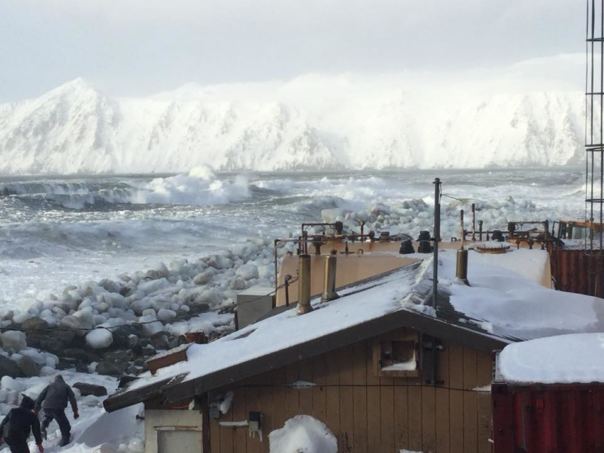
It’s been a record-breaking winter in Western Alaska. Temperatures in parts of the state have reached more than 40 degrees above normal, and sea ice cover in the Bering Sea has dropped to levels never before recorded.
Last week, social media across the region lit up as residents posted photos and videos of open water where, normally, there’s ice. In some communities, people say it’s the first time they can remember seeing wide open water in February.
The tiny island village of Diomede, in the middle of the Bering Strait, got national attention after a resident posted a video of giant waves crashing onto shore and surging between buildings during a storm on Feb. 20.
This is what record low sea ice in the Arctic means on the ground: stunning FB video taken Tuesday Feb 20 from Little Diomede, Alaska, smack in the middle of Bering Strait. Scary stuff, on many levels. #akwx #Arctic @Climatologist49 @ZLabe https://t.co/e2Hb4Rvgry
— Rick Thoman (@AlaskaWx) February 21, 2018
Beyond the waves? Open water, all the way to the horizon.
And that’s definitely not normal, tribal coordinator Frances Ozenna said.
“This is really amazing to see, this change,” Ozenna said in a phone interview Friday. “I don’t think anybody was really expecting this to happen.”
Ozenna said it’s the first time she can remember ever seeing this much open water in front of Diomede at this time of year: normally the sea ice grows from January all the way through March. But this year, it’s been unpredictable, she said, moving every day, with water opening and closing.
Then on Feb. 20, a major storm blew away what ice there was, and left the village without protection from the waves. The storm flooded Diomede’s water treatment plant and knocked out power. Chunks of ice and debris were tossed onto the beach and the village’s heliport.
“It’s very odd,” Ozenna said. “This is supposed to be the coldest time of the year.”
It’s not just Diomede. The entire Bering Sea is seeing record low levels of sea ice, said Brian Brettschneider, a climatologist based in Anchorage. Brettschneider said ice in the Bering Sea is currently at the lowest level in nearly 40 years of satellite data.
Part of the issue is warm temperatures: Brettshneider said parts of Western Alaska and the North Slope, including St. Paul, Kotzebue and Utqiagvik, are having their warmest winter on record.
“You have warm air running over record warm water,” Brettschneider said. “It’s really hard to get sea ice to form in that situation.”
The drastic drop this year might be an anomaly. Brettschneider said he wouldn’t be surprised if next year, sea ice levels are significantly higher. But he said the overall pattern is clear.
“The trend line certainly is bad,” Brettscheinder said. “My interpretation of that is, this is going to be more likely than not in the years to come.”
That’s left people like Ambrose Towarak shaking their heads.
Towarak is a commercial fisherman in Unalakleet, on Norton Sound. He posted a photo on Facebook of open water in front of town – something he also said he’s never seen this time of year.
“Everybody in the community is like, ‘It’s February! We shouldn’t be hearing ocean waves crashing on the beach,’” Towarak said in an interview Friday.
But that’s exactly what’s happening. Towarak’s friend Jeff Erickson posted a video on Facebook showing waves rolling onto the shore.
In a comment below the video, Erickson posted the lyrics to Bob Dylan’s 1960s anthem.
“In the words of an ancient sage,” Erickson wrote, “…the times, they are a-changin’.”
Rachel Waldholz covers energy and the environment for Alaska's Energy Desk, a collaboration between Alaska Public Media, KTOO in Juneau and KUCB in Unalaska. Before coming to Anchorage, she spent two years reporting for Raven Radio in Sitka. Rachel studied documentary production at the UC Berkeley Graduate School of Journalism, and her short film, A Confused War won several awards. Her work has appeared on Morning Edition, All Things Considered, and Marketplace, among other outlets.
rwaldholz (at) alaskapublic (dot) org | 907.550.8432 | About Rachel




